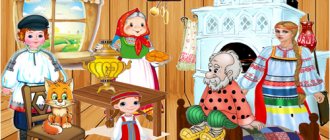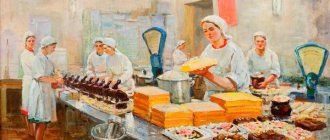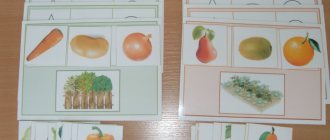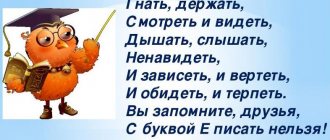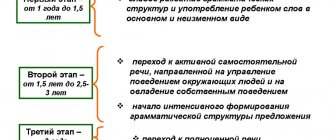Text of the book “Classes on speech development in the senior group of kindergarten. Lesson Plans"
V.V. Gerbova
Classes on speech development in the senior group of kindergarten
Lesson Plans
Library “Programs of education and training in kindergarten” under the general editorship of M. A. Vasilyeva, V.V. Gerbova, T. S. Komarova
Gerbova Valentina Viktorovna –
Candidate of Pedagogical Sciences, author of manuals on methods of developing children’s speech and introducing them to fiction.
From the author
The successful implementation of program objectives depends on a number of factors and, above all, on the way of life of a preschool institution, the atmosphere in which the child is raised, and on a specially designed, thoughtful developmental environment.
The effectiveness of education and training is achieved through the painstaking work of teachers who work directly with children and all preschool employees who communicate with preschoolers during the day.
The system of work on teaching children their native language and introducing them to fiction is presented in the works of V.V. Gerbova “Development of speech in kindergarten” (M.: Mozaika-Sintez, 2008), “Introducing children to fiction” (M.: Mozaika-Sintez, 2008).
The manual “Classes on speech development in the senior group of kindergarten”, written within the framework of the “Program of education and training in kindergarten”, edited by M. A. Vasilyeva, V.V. Gerbova, T.S. Komarova, supplements recommendations on the most important area of pedagogical activity - targeted and systematic training of preschoolers in the classroom. The practical purpose of the book is to provide educators with approximate guidelines for planning lessons (defining topics and learning goals, ways to implement them).
Features of speech development in children of the sixth year of life
Speech is a tool for the development of the higher parts of the preschooler’s psyche. By teaching a child to speak, adults simultaneously contribute to the development of his intellect. The development of intelligence is a central task in the training and education of children of senior preschool age.
The power of the native language as a factor that develops the intellect and nurtures emotions and will lies in its nature - in its ability to serve as a means of communication between a person and the outside world. The sign system of language - morphemes, words, phrases, sentences - encodes (encrypts) the reality surrounding a person.
The pace of speech development depends on the perfection of speech skills (especially phonetic and grammatical). What are the speech skills of children 5–6 years old and what determines their successful development at this age stage?
As you know, the period of highest speech activity is the fifth year of life. According to A. Gvozdev, by the age of five children master a complex system of grammar
, including syntactic and morphological patterns, and on an intuitive level correctly use words that are exceptions to the rules.
The level of vocabulary development is also quite high
.
Synonyms, antonyms, figurative comparisons and contrasts appear in children's speech. Preschoolers use nouns with different suffixes without errors (bear - bear cub - bear cub - bear - bear)
.
In their stories there are surprisingly accurate assessments of objects and phenomena (fat, fidgety, icicle-shaped)
.
Children begin to use adjectives in different degrees of comparison (heavy - very heavy - lighter - the lightest)
, as well as designations of shades of colors
(lilac, lilac, crimson, dark gray, etc.)
.
The number of verbs increases noticeably, and preschoolers use synonyms with different emotional connotations (walks - walks - paces - trudges - wanders)
. In children's statements, many words appear that relate to different parts of speech and denote the activities of people, their relationships, actions, behavior, experiences. Apparently, this is due to the fact that the period from five to seven years is the age of development of socially standardized speech (P. Blonsky and others).
In situations that require something to be compared, explained and proven, the speech of a child of the sixth year of life becomes more difficult. Cumbersome statements that are not divided into sentences appear (“Then the prince wanted to live with Cinderella forever, but he had such work at home that he was always working, could not leave this work and only went to Cinderella,” - Alyosha, 5 years 8 months ).
By the age of five, not all children master the correct pronunciation of sounds.
: some may have delays in their assimilation, others may have their incorrect formation (for example, guttural or single-beat pronunciation of the sound
r
, etc.).
Some children do not differentiate by ear and pronunciation between whistling and hissing sounds, and sometimes even the sounds r
and
l
.
This leads to the fact that the child does not always correctly pronounce words in a sentence containing several words with sounds that sound similar to him ( s - z, s - ts, ch - shch,
etc.). The cause of incorrect pronunciation of sounds and unclear speech may be defects in the structure of the speech organs, insufficient mobility of the muscles of the articulatory apparatus. These children require special attention from a speech therapist and educators.
The rapid pace of mastery of the native language, characteristic of the fifth year of a child’s life, slows down in the sixth year of life. Researchers of children's speech believe that after the age of five, speech skills improve only slightly, and some become even worse. Thus, the number of short requests and orders increases (Move away! Put it here!)
and the number of friendly, well-reasoned, and explanatory remarks decreases.
(Don’t bother me, please, don’t you see, I’m starting the plane!)
According to G. Lyamina, the number of cases of explanatory speech is halved. Now children are less likely to accompany their actions with speech. However, if a 5-6 year old preschooler is presented with a task that he has difficulty solving, he develops external speech, although not directly addressed to the interlocutor (the experiments of L. Vygotsky, described by A. Luria). Psychologists explain this by the fact that in older preschool age a new function of speech is formed - intellectual, that is, planning, regulating practical actions (speech “for oneself”, speech mastery of one’s own behavior). The intellectual function of speech has a communicative purpose, since planning one’s behavior and solving mental problems are components of the activity of communication.
Features of working with children in the classroom
Organization of speech development classes
In the older group, adult speech still remains the main source of speech development for preschool children.
When teaching children sound pronunciation, it is necessary to clearly and correctly articulate speech sounds and their combinations; practice voice modulation (voice strength, pitch, speech rate, timbre) when expressing various feelings: joy, annoyance, approval, affection, bewilderment, etc.
The formation of lexical and grammatical skills is determined by how seriously the teacher listens to the answers and reasoning of each child, helps him express his thoughts, promptly suggesting more accurate and appropriate words.
Different speech styles are determined by the synonymy of the language: lexical, grammatical, phonological (variety of intonations when pronouncing the same phrase). And the more synonymous words children hear and use, the richer and more expressive their speech will be.
Diverse vocabulary
is constantly updated as the child enriches his experience with new impressions and information. At the same time, the teacher needs to clarify and activate the vocabulary in the process of communicating with children in everyday, play situations and in the classroom. For this purpose, special didactic games and exercises are used. Some of them are carried out based on clarity: “Tops - roots”, “Who is the odd one out and why?” (“What’s extra?”), “Determine by touch” (the material from which the object is made: silk, velvet, gauze, etc.), “What’s wrong?” (confusion pictures), “What has changed?” and so on. Verbal didactic exercises are also effective: “Who will say otherwise?”, “Who will notice more?” (qualities, details), “Who will tell you more?”, “What about the other way around?” (use of antonyms), etc.
A special place is occupied by exercises in which the teacher and children make up various absurdities: “Wow!” (“In the spring, the animals had cubs: the elephant had a fox cub, the fox had a hedgehog...” The teacher invites the children to continue the story); “Whoever screams” (“And we found ourselves in a wondrous country. There elephants meow, frogs crow,” etc.); “What in the world doesn’t happen?” (“Fishes fly, roosters hatch chickens, mice hunt cats,” etc.) These exercises prepare children to participate in fun games (“Whatever happens, happens,” “Who was it?”), effective both for activation of the vocabulary, and for the development of imagination, the ability to joke and laugh.
With the help of a variety of games, children also master the morphological means of language
. For this purpose, it is necessary to pay attention to the sound of the grammatical form, the sound design of a particular grammatical category. These requirements are met by exercises that require:
• listen to the sound of some words (refrigerator, all-terrain vehicle, navigator, rocket carrier)
and explain their etymology;
• form words with the same root (kot – kotok – Kotofeich
and so on.
)
;
• form nouns by analogy (sugar bowl – rusk bowl)
, adjectives
(eared – big-eyed – handy)
;
correctly use indeclinable nouns, comparative degrees of adjectives (clean - cleaner, sweet - sweeter
, etc.
)
.
Special linguistic means should be introduced into the active vocabulary of children, with the help of which they can connect the structural parts of a judgment (because, after all)
, to specify a thought
(for example, here)
, to generalize what was said
(always, never)
.
To improve the syntactic side of speech
It is important in the learning process to create situations in which the child must explain something to the teacher or peers (an error in a friend’s story, a rule of the game), convince others of something, prove something.
It is necessary to teach children to understand questions and answer them correctly: how would you do it? how can I help? etc. When answering questions, especially when discussing moral and everyday situations, children should give detailed answers. The teacher should evaluate not only the content of the answer, but also its verbal presentation. (“Oli’s answer was strange. Listen to what she said and help correct the mistakes.”)
When characterizing objects, children of the sixth year of life name color, size and other distinctive features, which contributes to the appearance in their speech of sentences with homogeneous members. It is important that the teacher o.)
Older preschoolers rarely use subordinate clauses, so when analyzing their statements, complex sentences composed by children should be repeated. (“Dima’s answer pleased me. Listen to him again.”)
Preschoolers can be taught to use complex sentences using the “Complete (complete) sentence” technique. (“Autumn brings me sadness because...”, “We called so that...”, “We called when...”, “We decided to make a stop because...”) For the same purpose, children decipher a letter that was caught in the rain, dictate the text of a letter to a sick teacher (peer).
Children rarely use verbs in the subjunctive mood in their speech, and if they do, it is usually with errors. Therefore, it is useful to practice them in constructing statements on topics such as: “If I were a teacher” (Santa Claus, clown, cook, etc.).
In the older group, children are taught to differentiate the most commonly mixed sounds:
hissing and whistling
(w - s, zh - z, h - c, sh - s),
voiced and unvoiced
(v - f, z - s, g - w, b - p, d - t, g - k),
sonorous
(l
and
r).
The classes use special games and exercises aimed at developing the sound culture of speech.
• The teacher mixes up two similar-sounding sounds, for example, w
and
h,
and children (by prior agreement) show movements that characterize the image with which the sound is associated:
g
– movement with both hands (“a bug is flying”),
h –
waving movement with the hand (“scaring away a mosquito”), etc. . First, the teacher finds out how the children understood the task, and then works with the whole group. Then the girls perform the exercise, and the boys observe and analyze the results; then only boys (or children sitting at the first tables, etc.) complete the task. The teacher takes note of those who make mistakes and identifies the cause of the difficulties (the child does not differentiate sounds, does not have time to work at a given pace, which is very important for the future student). In order to set a certain pace of work, the teacher, having uttered sounds (later words), counts to himself: “One, two, three,” and raises his right hand, giving the children the signal: “Put your hands on the table!”
• The teacher pronounces 9 – 11 words with similar sounds, for example, zh – z,
and the children, as in the previous task, show the corresponding movements.
The teacher selects not only nouns, but also verbs, adjectives, adverbs (crane, umbrella, squint, green, yellow, tomorrow, from afar, vest, buzzing,
etc.).
• The teacher reads the entire rhyme or the passage needed for work 2–3 times.
The mouse in the green mug made some millet porridge.
A dozen kids are waiting for dinner. Czech song, translation by S. Marshak
The teacher suggests naming words with the sound w
.
It is easier for children to complete this task if supporting objects are used. (“I put three pyramids on the table. This means that we need to name three words with the sound w
that are found in the sentence: “A dozen kids are waiting for dinner.”) As they are named, the teacher removes the objects.
• The teacher asks the children to remember and name words containing a certain sound (names of objects, actions, qualities, etc.).
• The teacher invites the children to choose similar-sounding (rhyming) words: chamomile - bug - zamarashka - tumbler; top - bull - knot - cricket - old man - heel - Cossack; bird - little songbird - little blueberry - strawberry - blackberry - little one
.
• The teacher plays the game “Say (prompt) a word.” (Speech material for this exercise can be taken from a variety of educational books for preschool children and children's magazines.)
The hunter shouted: “Oh! The doors (animals)
are chasing me!
There are no roads in the swamp. I’m on the cats (bumps)
- hop and hop!”A. Shibaev “The letter got lost”
• Children (based on pictures) form a “chain of words.” Guessing what sound the word bus
, the guys name the second picture, which depicts an object whose name begins with the last sound of the first word
(sledge).
Next, the children choose pictures on their own. It is important that each child can create his own chain of words by receiving an initial picture from the teacher or choosing it independently. (Children should have a lot of pictures at their disposal[1].) The child who correctly compiled the longest chain within a certain period of time wins.
Older preschoolers often disrupt their fluency of speech because, while gasping for air, they finish long sentences while exhaling. Therefore, you need to monitor their breathing
and practice the quiet, drawn-out pronunciation of sounds
and, y
, onomatopoeia
au
, words
echo
.
The development of speech breathing is facilitated by pronouncing tongue twisters. First, the teacher reminds the text, then the children recite it several times in chorus at different tempos. After this, you can begin individual exercises (speaking at a fast pace).
dictionaries in preschool
. For five-year-old children, spelling is more suitable. The teacher should show it to the children, tell them what a wonderful and unusual book it is, and provide the opportunity to explore the dictionary: “Maybe you can guess why I praise this book so much with a strange arrangement of text and no pictures.”
After listening to the children's reasoning and ideas, the teacher tells them what a dictionary is and shows them columns of words starting with a specific letter of the alphabet. You can play with the children. Let's give an example.
…
Game “Who can name the most words starting with the letter (A)”?
“So, you were able to remember twelve words starting with the letter A,” says the teacher. – This is a lot, but there are much more of them in the dictionary, maybe a hundred or two hundred. Now I will name words starting with the letter A, which I especially enjoy pronouncing, and you will try to explain what they mean: lampshade, apricot, August, aviation, autograph, alphabet, adagio, admiral, adjutant, openwork, amethyst...
So, for now you only know five words out of eleven, but I am sure that at the end of the year you will know the meaning of a much larger number of words. Our music worker must be surprised to hear the word “adagio” from your lips. Let's ask him to let us listen to a recording of the adagio from the ballet."
You can access dictionaries at any time convenient for preschoolers and the teacher: indoors and outdoors, communicating with all children or only with those who want to hear different words starting with a familiar letter. While listening to children's interpretation of words, the teacher should not forget to correct their speech, suggest which word is appropriate to use in a given case and how to construct a phrase or small statement more correctly. Exercises based on reading words from the dictionary to children and interpreting them, at first glance, are formal in nature. However, older preschoolers like them, and their results are amazing: children’s vocabulary is enriched, a steady interest in the meaning of words appears; they begin to listen and hear the teacher’s story differently, perceiving not only its meaning, but also its speech design. As a result, children have questions like: “What did you name him?”, “What did you just say?”, “Did you say a new word?”
In the process of communicating with children in the classroom and in everyday life, it is necessary to improve dialogical speech
. And although dialogue is arbitrary contextual speech, it must be taught using a variety of games and exercises, involving interaction with a teacher - the bearer of communicative culture. This manual presents classes in which children master the rules of behavior and learn cultural speech interaction. In the classroom, you can use visual didactic aids that allow children to solve practical problems using their accumulated life experience (for example: Gerbova V.V. Speech development in kindergarten. Visual didactic aid for classes with children 4–6 years old. – M.: Mosaic-Synthesis, 2009.)
Serious attention should be paid to teaching children to tell stories
: retelling, describing an object, composing a story based on a picture and pictures with a sequentially developing action.
In the older group, children begin to be taught retelling
. It is very important to choose the right text for this type of work. The text should captivate the child so emotionally that he listens to it with interest many times, both when performed by an adult and when retold by peers (for example, V. Bianchi’s story “Bathing the Bear Cubs”).
At the beginning of the year, many children need the help of an adult when retelling. He should start the story, and the child should continue it. During the retelling process, if necessary, it is appropriate to prompt the child with the desired phrase. In the second half of the year, children learn to retell the text together. The child must decide for himself when to stop so that the second storyteller (chosen by the child himself) can take over the baton. The ability to divide a text into parts, maintaining the logical completeness of passages, will be necessary for children at school.
In the older group, a lot of attention is paid to working with pictures.
. Children's ability to name individual pictures and several pictures at the same time is improved; tell meaningfully and consistently, guided by a plan.
A plan is drawn up when children first become acquainted with the picture. Let's give an example.
…
The teacher, setting the children up for viewing, offers attention to the initial phrase(s) of the future story: “On a warm summer evening, the hedgehog took the hedgehogs out into a forest clearing. Everyone is busy with what." Next, the teacher tells the children where it is most convenient to start looking at the picture: “Hedgehogs have a lot to do. They scattered throughout the clearing. It is so? Tell us about it..."
While listening to the children, the teacher asks clarifying questions, suggests more precise words that characterize the situation, and summarizes what was said in a short story.
Then the teacher draws the children’s attention to another part of the picture: “The hedgehog does not bother the kids. She has her own business, doesn't she? Tell me, what are these things?”
The teacher again summarizes the preschoolers' stories and turns their attention to the perception of the last object (the beauty of the meadow). The teacher ends the examination with a final phrase that conveys his attitude towards the picture: “It’s good for hedgehogs in a forest clearing on a warm summer evening!”
With this organization of work, children talk about the picture without repetitions or omissions, since the teacher unobtrusively suggested to them a plan consisting of only three points.
In the older group, children’s ability to create pictures is consolidated and developed using a matrix painting and handout pictures.
Looking at pictures with plot development (with sequentially developing action)
, children are happy to arrange them in a certain sequence and comment on their actions, using quite a lot of complex sentences. The logic, completeness and imagery of children’s stories are determined both by the content of the pictures and by the nature of the questions and tasks provided by the teacher. Pictures with plot development of action encourage children to compose creative stories and activate their imagination.
For classes with older preschoolers, you can use the following manuals: Gerbova V.V. Pictures on the development of speech in children of senior preschool age (M.: Prosveshchenie, any edition), Radlov N. Stories in pictures (any edition). You can also use appropriate pictures that are periodically published in children's illustrated magazines.
When working on pictures with sequentially developing action, the following features must be taken into account.
When asking children to arrange pictures in the correct sequence, it is necessary to provide them with the opportunity to discuss their actions. This moment is most favorable for practicing such speech formulas as: “I believe (I think, I am sure, I believe) that the row is lined up correctly”; “I have some doubts (there are objections)”; “It seems to me that Sasha made a small mistake”; “I would like (I will try) to explain my actions.” First, the teacher will have to tell the children for a long time and persistently about what words are appropriate in a particular address, about how they enrich a person’s speech. Over time, the children themselves will begin to tell the teacher how in this or that case they can turn to an adult or peer. And then non-standard speech patterns will appear in children’s independent speech.
A lesson on composing a story using pictures should be structured as follows.
Having approved the sequence of pictures, the teacher invites the child (from among those who wish) to compose a narrative story based on the first picture. The teacher listens to the answer and finds out from the children what else could be included in the story to make it more interesting and meaningful. (“I believe that...”; “It seems to me that...”; “I’m not sure, but it seems to me that...”) Then the teacher invites another child (optional) to make up a story based on the second picture. And so on.
In conclusion, one of the children makes up a story based on all the pictures. The teacher finds out if there are anyone else who wants to write a story. If necessary, the teacher invites the children to listen to their story and asks them to pay attention to unusual and rarely encountered words.
Pictures with sequential action are excellent material for creative storytelling
. When arranging pictures in a certain sequence, children discover that some important culminating plot is missing (usually the third picture). This activates their imagination and makes them think about what happened to the characters.
It is useful to train children in composing endings to folk tales that they know well.
. For example, the teacher reads or tells the Russian folk tale “The Braggart Hare” (arranged by O. Kapitsa) until the words: “The hare saw the dogs scolding the crow, and thought...” What exactly did the hare think about, did he dare to help the crow or was he afraid if helped, then how, and if he didn’t help, then how he later justified himself - all this is made up by children. Then the teacher reads the end of the fairy tale.
Or the teacher tells the children the Nenets folk tale “Cuckoo” (translation by K. Shavrov) to the words: “Brothers, look, look, our mother is flying away like a bird!” - shouted the eldest son.” Children continue the fairy tale.
You can compose an ending to the fairy tale by D. Bisset “About the tiger cub Binky, whose stripes disappeared” (retelling from English by N. Shereshevskaya). Children figure out where the tiger cub looked for the stripes, who he asked to lend them to him or draw them, and how his adventures ended.
And the fairy tales of J. Rodari, which have three endings (“The Dog That Couldn’t Bark”, etc.), are good didactic material that focuses on creative storytelling.
Outside of class, it is useful to practice children writing short fairy tales.
without relying on literary texts. The teacher sets a topic for the children, helps them compose a story and present it clearly to the audience. You can offer children the following topics:
• a fairy tale about how a bear cub caught the moon;
• a fairy tale about how a polar bear wandered into Africa and what came of it;
• a fairy tale about how a rude hedgehog and a good little bunny traveled;
• a fairy tale about how a badger gained courage.
The senior group continues to improve their ability to write stories on topics from personal experience
. Here, too, the choice of topic and the presence of a story plan are very important. You can offer the children the following topics: “How we congratulated the kindergarten staff on the holiday,” “How we looked for traces of autumn” (collective experience); “My favorite toy (favorite cartoon)”, “Our mischievous cat (my dog friend)”, etc.
